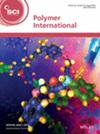Lohana Vieira Bataglini, Maria Luiza Paganini Maia, Bruna Louise Silva, Marlene Bampi, Luana Bettanin, Marcia Bär Schuster
下载PDF
{"title":"热固性基体的增韧:三嵌段共聚物加成及PEG和PPG嵌段顺序对相形貌的影响","authors":"Lohana Vieira Bataglini, Maria Luiza Paganini Maia, Bruna Louise Silva, Marlene Bampi, Luana Bettanin, Marcia Bär Schuster","doi":"10.1002/pi.70000","DOIUrl":null,"url":null,"abstract":"<p>In this study, an epoxy resin (diglycidyl ether of bisphenol A) was modified with triblock copolymers: poly(ethylene glycol)–poly(propylene glycol)–poly(ethylene glycol) (PEG-PPG-PEG) or PPG-PEG-PPG, with 10 wt% PEG in their structure, referred to as EPE and PEP, respectively. The aim was to evaluate the influence of the PEG and PPG block sequence on the phase morphology and enhance the fracture toughness of the thermoset matrix. Scanning electron microscopy revealed immiscibility for PEP systems and partially miscible to immiscible behavior for EPE systems, depending on the mass fraction used. The EPE fraction reduced the size of the dispersed phase, while the PPG end-group block sequence in PEP suppressed coalescence, stabilizing the dispersion and decreasing dispersed phase size. Differential scanning calorimetry showed a reduction of <i>ca</i> 20 °C in the glass transition temperature for the EPE systems, while for the PEP systems there were no significant changes, corroborating the immiscible system found in microscopy. Analysis of the mechanical properties revealed that incorporating the copolymer enhanced fracture energy absorption, as demonstrated by the increased toughness (up to 41%) compared to the neat epoxy. Systems with smaller spherical/ellipsoidal domains exhibited greater toughness, indicating that particle distribution and size significantly influence the material's toughness. Regarding tensile results, a reduction in tensile strength values was observed for all modified systems, especially for the EPE-10 system. These findings underscore the significance of the block sequence in triblock copolymers, emphasizing the importance of tailoring specific morphologies to enhance mechanical properties. © 2025 The Author(s). <i>Polymer International</i> published by John Wiley & Sons Ltd on behalf of Society of Chemical Industry.</p>","PeriodicalId":20404,"journal":{"name":"Polymer International","volume":"74 10","pages":"927-935"},"PeriodicalIF":3.6000,"publicationDate":"2025-06-26","publicationTypes":"Journal Article","fieldsOfStudy":null,"isOpenAccess":false,"openAccessPdf":"https://scijournals.onlinelibrary.wiley.com/doi/epdf/10.1002/pi.70000","citationCount":"0","resultStr":"{\"title\":\"Toughening of thermoset matrix: effect of triblock copolymer addition and block sequence of PEG and PPG on phase morphology\",\"authors\":\"Lohana Vieira Bataglini, Maria Luiza Paganini Maia, Bruna Louise Silva, Marlene Bampi, Luana Bettanin, Marcia Bär Schuster\",\"doi\":\"10.1002/pi.70000\",\"DOIUrl\":null,\"url\":null,\"abstract\":\"<p>In this study, an epoxy resin (diglycidyl ether of bisphenol A) was modified with triblock copolymers: poly(ethylene glycol)–poly(propylene glycol)–poly(ethylene glycol) (PEG-PPG-PEG) or PPG-PEG-PPG, with 10 wt% PEG in their structure, referred to as EPE and PEP, respectively. The aim was to evaluate the influence of the PEG and PPG block sequence on the phase morphology and enhance the fracture toughness of the thermoset matrix. Scanning electron microscopy revealed immiscibility for PEP systems and partially miscible to immiscible behavior for EPE systems, depending on the mass fraction used. The EPE fraction reduced the size of the dispersed phase, while the PPG end-group block sequence in PEP suppressed coalescence, stabilizing the dispersion and decreasing dispersed phase size. Differential scanning calorimetry showed a reduction of <i>ca</i> 20 °C in the glass transition temperature for the EPE systems, while for the PEP systems there were no significant changes, corroborating the immiscible system found in microscopy. Analysis of the mechanical properties revealed that incorporating the copolymer enhanced fracture energy absorption, as demonstrated by the increased toughness (up to 41%) compared to the neat epoxy. Systems with smaller spherical/ellipsoidal domains exhibited greater toughness, indicating that particle distribution and size significantly influence the material's toughness. Regarding tensile results, a reduction in tensile strength values was observed for all modified systems, especially for the EPE-10 system. These findings underscore the significance of the block sequence in triblock copolymers, emphasizing the importance of tailoring specific morphologies to enhance mechanical properties. © 2025 The Author(s). <i>Polymer International</i> published by John Wiley & Sons Ltd on behalf of Society of Chemical Industry.</p>\",\"PeriodicalId\":20404,\"journal\":{\"name\":\"Polymer International\",\"volume\":\"74 10\",\"pages\":\"927-935\"},\"PeriodicalIF\":3.6000,\"publicationDate\":\"2025-06-26\",\"publicationTypes\":\"Journal Article\",\"fieldsOfStudy\":null,\"isOpenAccess\":false,\"openAccessPdf\":\"https://scijournals.onlinelibrary.wiley.com/doi/epdf/10.1002/pi.70000\",\"citationCount\":\"0\",\"resultStr\":null,\"platform\":\"Semanticscholar\",\"paperid\":null,\"PeriodicalName\":\"Polymer International\",\"FirstCategoryId\":\"92\",\"ListUrlMain\":\"https://scijournals.onlinelibrary.wiley.com/doi/10.1002/pi.70000\",\"RegionNum\":4,\"RegionCategory\":\"化学\",\"ArticlePicture\":[],\"TitleCN\":null,\"AbstractTextCN\":null,\"PMCID\":null,\"EPubDate\":\"\",\"PubModel\":\"\",\"JCR\":\"Q2\",\"JCRName\":\"POLYMER SCIENCE\",\"Score\":null,\"Total\":0}","platform":"Semanticscholar","paperid":null,"PeriodicalName":"Polymer International","FirstCategoryId":"92","ListUrlMain":"https://scijournals.onlinelibrary.wiley.com/doi/10.1002/pi.70000","RegionNum":4,"RegionCategory":"化学","ArticlePicture":[],"TitleCN":null,"AbstractTextCN":null,"PMCID":null,"EPubDate":"","PubModel":"","JCR":"Q2","JCRName":"POLYMER SCIENCE","Score":null,"Total":0}
引用次数: 0
引用
批量引用




 求助内容:
求助内容: 应助结果提醒方式:
应助结果提醒方式:


